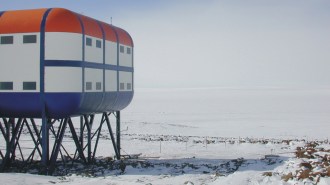By isolating single layers from materials with naturally layered structures, physicists in England and Russia have created what they say are the world’s thinnest freestanding materials, some just one atom thick.
The liberated layers are surprisingly robust, persisting as flat sheets at room temperature and preserving their crystalline structures, the scientists report in the July 26 Proceedings of the National Academy of Sciences. What’s more, the freed sheets can differ from their parent materials in key properties.
“It’s really the thinnest material possible,” says Kostya S. Novoselov of the University of Manchester in England.
So far, the scientists have whittled down five industrial materials to such skimpy dimensions. The substances include the solid lubricant molybdenum disulfide and a bismuth-based superconductor (SN: 11/18/00, p. 330: Little Big Wire).
While the longest stretches of thin materials to date span scarcely a tenth of a millimeter, the researchers foresee making larger pieces. Among the potential applications for the structures are micromachines that flex under electrical stimulation and novel transistors and sensors.







